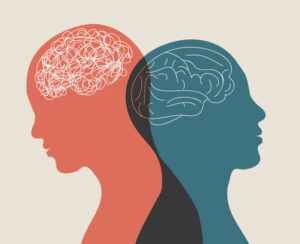Panic attacks can be overwhelming and debilitating, causing intense fear, physical symptoms, and a sense of losing control. If you or someone you know experiences panic attacks, it’s essential to understand that help is available. One highly effective approach is Cognitive Behavioral Therapy (CBT). In this article, we’ll explore what CBT is, how it works, and its benefits in managing and preventing panic attacks.
Contents
Understanding Panic Attacks
Panic attacks are sudden, intense episodes of fear or anxiety. They often include symptoms like rapid heartbeat, shortness of breath, trembling, and a feeling of impending doom. These attacks can be triggered by various stressors, such as phobias, trauma, or even seemingly unrelated situations.
Understanding the triggers of panic attacks is crucial for effective management. Common triggers include specific situations (like public speaking), emotional stress, or even physical sensations like a racing heart.
The Role of Cognitive Behavioral Therapy (CBT)

It is based on the idea that our thoughts, feelings, and behaviors are interconnected, and by identifying and modifying negative thought patterns and behaviors, individuals can effectively manage and reduce their panic attacks. Here’s how CBT plays a crucial role in the treatment of panic attacks:
Identifying and Understanding Panic Triggers:
- CBT begins by helping individuals identify the specific situations, thoughts, and physical sensations that trigger their panic attacks. This is often done through self-monitoring and keeping a panic diary.
- By recognizing these triggers, individuals can gain insight into the factors that contribute to their panic attacks.
Cognitive Restructuring:
- One of the core components of CBT for panic attacks is cognitive restructuring. This involves challenging and changing irrational or catastrophic thought patterns that often accompany panic attacks.
- Therapists work with individuals to help them recognize and replace negative thoughts with more rational and balanced ones. For example, changing “I’m going to die” to “This is uncomfortable, but it’s not life-threatening.”
Education and Psychoeducation:
- CBT also provides individuals with education about the physiological processes involved in panic attacks. Understanding the fight-or-flight response and how it relates to panic can demystify the experience and reduce fear.
- Psychoeducation about the nature of anxiety disorders and panic attacks can help individuals feel less alone and stigmatized, which can contribute to recovery.
Exposure Therapy:
- Exposure therapy is another component of CBT for panic attacks. It involves gradually exposing individuals to situations or triggers that provoke panic, with the guidance of a therapist.
- This controlled exposure allows individuals to learn that their feared outcomes (e.g., passing out or losing control) do not occur, helping to reduce anxiety over time.
Relaxation and Coping Strategies:
- CBT teaches individuals various relaxation and coping strategies to manage panic symptoms. These may include deep breathing exercises, progressive muscle relaxation, and mindfulness techniques.
- Learning these techniques can help individuals stay calm and reduce the intensity and duration of panic attacks.
Benefits of CBT for Panic Attacks

Here are some of the key benefits of CBT for panic attacks:
- Effective Symptom Reduction: CBT has a strong track record of reducing the frequency, severity, and intensity of panic attacks. Many individuals experience a significant decrease in panic attack symptoms during and after completing a course of CBT.
- Long-lasting Results: CBT not only helps manage immediate panic attack symptoms but also equips individuals with skills and strategies to prevent future attacks and manage anxiety over the long term. It focuses on addressing the root causes and thought patterns that contribute to panic attacks, which can lead to lasting improvements.
- Cognitive Restructuring: CBT helps individuals identify and challenge irrational or catastrophic thought patterns that often accompany panic attacks. By replacing these negative thoughts with more balanced and rational ones, individuals can reduce the fear and anxiety associated with panic.
- Empowerment: CBT empowers individuals to take an active role in their treatment. By learning coping strategies, relaxation techniques, and problem-solving skills, individuals become more self-reliant and confident in managing their panic attacks and anxiety.
- Skill-building: CBT provides individuals with a toolbox of practical skills and techniques they can use to manage panic attacks and anxiety in various situations. This includes deep breathing exercises, progressive muscle relaxation, exposure therapy, and mindfulness techniques.
- Customization: CBT is highly adaptable and individualized. Therapists work with each person to tailor the treatment to their specific needs, triggers, and goals. This personalized approach enhances the effectiveness of the therapy.
Getting Started with CBT
Whether you’re seeking therapy for panic attacks, anxiety, depression, or any other issue, here’s a guide to help you begin your CBT journey:
Recognize the Need for Therapy:
- Acknowledge that you may benefit from therapy. This realization often comes when you’ve noticed persistent emotional or psychological difficulties that interfere with your daily life.
Consult a Healthcare Professional:
- Start by consulting a healthcare professional, such as a primary care physician or psychiatrist. They can help assess your condition, provide referrals to CBT therapists, and determine whether medication may be necessary or helpful alongside therapy.
Find a CBT Therapist:
- Look for a licensed and experienced CBT therapist or counselor. You can do this through various means:
- Ask for referrals from your healthcare provider, friends, or family who may have had positive therapy experiences.
- Search online directories, such as Psychology Today or your insurance company’s provider list, to find therapists in your area.
- Contact local mental health clinics or organizations for recommendations.
- Look for a licensed and experienced CBT therapist or counselor. You can do this through various means:
Verify Therapist Credentials:
- Ensure that the therapist you choose is licensed and trained in CBT. You can check their credentials with your state’s licensing board or professional associations.
The CBT Process
The Cognitive Behavioral Therapy (CBT) process typically follows a structured and collaborative approach between the therapist and the individual seeking treatment. Here are the key stages and components of the CBT process:
- Initial Assessment: The process begins with an initial assessment where the therapist and the individual (client) meet to discuss the client’s concerns, goals for therapy, and background information. This assessment helps the therapist understand the client’s specific issues and needs.
- Setting Goals: Based on the assessment, the therapist and client collaboratively establish clear and specific goals for therapy. These goals should be realistic and measurable, providing a clear direction for the treatment.
- Educational Phase: The therapist provides psychoeducation about the nature of CBT and the principles behind it. This includes explaining how thoughts, feelings, and behaviors are interconnected and how negative thought patterns contribute to emotional distress.
- Identification of Negative Thought Patterns: In this phase, the client learns to identify their negative thought patterns, often referred to as “cognitive distortions.” These are irrational or unhelpful thoughts that can contribute to emotional distress. Common distortions include catastrophizing, black-and-white thinking, and overgeneralization.
Addressing Common Concerns About CBT

Here are some common concerns and misconceptions about CBT, along with explanations to address them:
Fear of Judgment:
- Concern: Some individuals worry that their therapist will judge them or their thoughts and feelings during CBT.
- Explanation: CBT is a non-judgmental and empathetic therapy. Therapists are trained to create a safe and supportive environment where clients can openly discuss their concerns without fear of judgment.
Length of Treatment:
- Concern: People may be concerned that CBT will be a lengthy and time-consuming process.
- Explanation: The duration of CBT varies depending on the individual’s needs and goals. It is often considered a time-limited therapy, typically spanning 12 to 16 sessions. Shorter or longer courses of treatment are possible, and progress is regularly assessed to ensure the therapy remains effective and efficient.
Ineffectiveness of Talk Therapy:
- Concern: Some may doubt the effectiveness of talking as a treatment for mental health issues.
- Explanation: CBT is not just about talking; it’s a structured and evidence-based approach that involves practical strategies and skill-building. It focuses on changing thought patterns and behaviors that contribute to emotional distress, leading to concrete improvements in mental health.
Fear of Revisiting Trauma:
- Concern: Individuals who have experienced trauma may worry that CBT will force them to relive or revisit painful memories.
- Explanation: CBT can be adapted to avoid retraumatization. Therapists use techniques such as cognitive restructuring and exposure therapy cautiously and collaboratively. The goal is to help individuals process and cope with traumatic experiences, not re-traumatize them.
Tips for Practicing CBT Techniques at Home
Here are some tips for effectively practicing CBT techniques at home:
- Educate Yourself: Start by learning about the fundamental principles of CBT. Understand the connection between thoughts, feelings, and behaviors, as well as common cognitive distortions (e.g., catastrophizing, all-or-nothing thinking).
- Keep a Journal: Maintain a thought journal or diary. When you notice a change in your mood or a strong emotion, write down the thoughts you were having at the time. This practice can help you identify patterns and cognitive distortions.
- Identify Negative Thought Patterns: Pay attention to recurring negative thought patterns. Ask yourself if your thoughts are overly negative, unrealistic, or unhelpful. Challenge these thoughts by questioning their accuracy and evidence.
- Practice Cognitive Restructuring: Challenge and reframe negative thoughts. When you identify unhelpful thoughts, work on replacing them with more balanced and rational alternatives. Ask yourself questions like, “What’s the evidence for this thought?” and “Is there a more balanced way to view this situation?”
- Set Realistic Goals: Establish clear and achievable goals for your CBT practice at home. These goals could include reducing anxiety in specific situations, managing stress, or improving self-esteem.
- Use Relaxation Techniques: Learn and practice relaxation techniques like deep breathing, progressive muscle relaxation, or mindfulness meditation. These exercises can help you manage stress and anxiety effectively.
Conclusion
CBT is a powerful tool for managing and preventing panic attacks. By understanding the triggers, learning CBT techniques, and seeking professional help when needed, individuals can regain control over their lives and experience significant relief from the grip of panic attacks.
If you are experiencing anxiety related issues, Online Anxiety Counseling at TherapyMantra can help: Book a trial Online therapy session.


